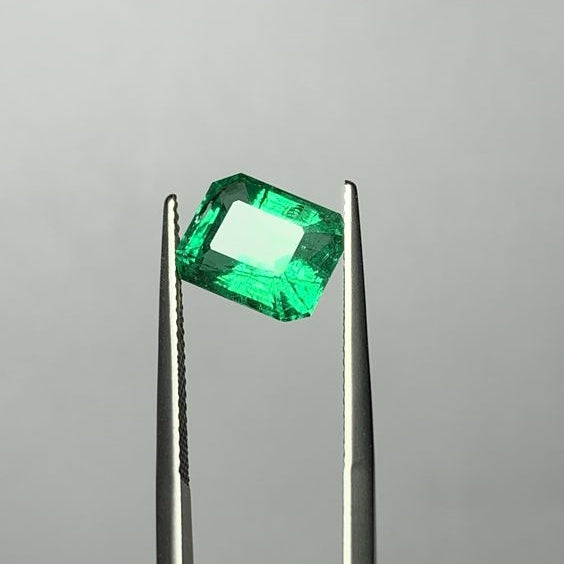The family of emeralds: The beryls
The most popular and high-end gemstones in the world are part of the large beryl family and have a chemical composition of Beryl. However, despite the infinity of stones belonging to this family, the emerald has the most beautiful and appreciated variety of beryl in the world.
Thanks to its chemical composition that makes it acquire an intense green color and its most notable impurities with traces of chromium, vanadium and iron, emeralds have become the most popular variety of beryl among lovers of precious gems, high jewelry and geological beauty.
Keep reading, because below we will detail which are the gems belonging to the beryl family, the role of the emerald in this family, and what are its main uses.
Emeralds, the most prominent beryl
Its name comes from the Sanskrit meaning "green" and it is perhaps the best known and most valuable variety within the beryl family. Their deep green color has made them desirable for centuries, with smears being
The emerald areas of the country are Boyacá and Cundinamarca. Located in the northwestern part of the department of Boyacá, Muzo , is where the largest deposits of this precious stone are concentrated, however, the mines of Borbur, Coscuez, Chivor, Peñas Blancas, La Pita and Quípama also stand out.
Likewise, Gachetá and Gachalá , two municipalities in the northeast of Cundinamarca, complete the most important area of emerald exploitation in the country.
Other varieties of beryl
While talking about the beryl family can be confusing when discussing gemstones, you may be aware of some gemstones that belong to this family and not know it. Well, many of them are used regularly in jewelry, although of course they do not have the word beryl in their name. These are some of them:
- Green beryl (light green)
This type of beryl has a pale green hue and should never be confused with emerald beryl even though it is quite often offered as such. That said, the main differential characteristic is that the green Beryl does not have the chromophore elements of the emerald (impurities, inclusions, carbons, and so on) and its color is considerably paler.
- Aquamarine (light teal)
This gem from the beryl family is colored by iron and occurs naturally as a pale bluish-green color, the more intense the blue color, the higher the value.
These stones usually do not contain inclusions, but may have a blemish called a "rain," which consists of long, thin tubes filled with gas or liquid that run parallel to each other. Rain, if it is abundant enough, can cause a cat's eye effect.
- Heliodor and golden beryl (yellow or gold)
Heliodor, also known as golden beryl, is yellow in color, so there is no clear boundary between one and the other. But the former often has a hint of green, while the latter is saturated yellow to yellow-orange. Since both are yellow beryls, the names are sometimes interchangeable in trade. And it is that both the Heliodoro and the golden beryl are very clean gems with few inclusions.
- Morganite (pink)
Morganite is the pink to orange-pinkish member of the beryl family. Although its existence was previously known in California, USA, the first morganites of a good size and color were found for the first time in 1910 in Madagascar.
Morganite has enjoyed increased popularity in the trade in recent years due to the high prices paid for pink diamonds such as the 'Sweet Josephine', a 16.08-carat pink diamond that sold for $28.5 million. dollars at Christie's Geneva in 2015.
- Goshenite (transparent)
Goshenite is a beryl in its purest form with no coloring agent mixed into the crystal structure during growth. Historically, because of its clarity, Goshenite beryl has been used for lenses and eyeglasses. It is occasionally used as a diamond simulant, however it does not possess the same fire or brilliance level.
- red beryl
Red beryl is a rare variety of beryl and is deep red in color. It is also called "red emerald" or bixbite in some areas of trade. The red emerald owes its color to small traces or impurities of manganese in the chemical composition of the mineral.
Natural emerald is green in color, however, manganese impurities cause the gem to take on an intense reddish hue. Thanks to this, this crystal is also known as scarlet emerald.
- pezzottaite
Discovered in 2003 and named after gemologist Federico Pezzotta, pezzottaite is a rare pinkish-red to pinkish-red gemstone. Initially, it was believed to be a red beryl, but it has since been discovered that chemical, optical, and physical properties separate this gemstone from the varieties mentioned above. It does not usually appear in jewelry due to its rarity and several of the mines where it has been unearthed are now out of print.
Paula A. Bonilla
Social communicator and journalist from Sergio Arboleda University in Colombia. She is also a jeweler and is passionate about constantly learning about precious gems and national high jewelry.
Currently, she is working for one of Bogotá's most important jewelry stores, Emerald by Love. This jewelry store has over 40 years of experience and has 2 physical branches in the capital city of Colombia, located in the city center.


